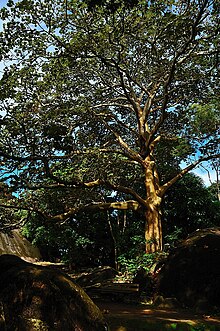Stink trees
| Stink trees | ||||||||||||
|---|---|---|---|---|---|---|---|---|---|---|---|---|

Sterculia foetida , leaves |
||||||||||||
| Systematics | ||||||||||||
|
||||||||||||
| Scientific name | ||||||||||||
| Sterculia | ||||||||||||
| L. |
Stink trees ( Sterculia ) are a genus of plants in the subfamily of the stink tree family (Sterculioideae) within the family of the mallow family (Malvaceae). It is distributed around the world with around 100 to 200 species in the tropics and subtropics . The greatest biodiversity is in tropical Asia. There are 26 species in China, 14 of them only there. These trees are named Stinkbaum because of the stinking smell of their flowers.
description

Appearance and leaves
Sterculia species grow as deciduous, mostly large trees or shrubs . Leaves and flowers often have a strong odor. The alternate leaves are simple, lobed or divided in the shape of a hand. The leaf margins are smooth or serrated. There are mostly short-lived stipules present.
Inflorescences and flowers
Laterally or terminally, mostly paniculate or less often racemose inflorescences are formed. Often there are hermaphroditic and / or unisexual flowers on one specimen ( monoecia or andromonoce ). The mostly radial symmetry flowers are five-fold. The five sepals are fused tubular or bell-shaped. Petals are missing. Stamens are (0) 10 to 30 present. (Three to) four to five carpels have become a top permanent ovary grown, they are free in the fruit. There are two to many ovules per carpel . The stamens are fused together and form an androgynophore with the gynoeceum . In the female flowers, the androgynophore is very short and staminodes are located in a ring around the base of the carpels. In the male flowers, the stamen tube encloses the rudimentary carpels. The style ends with as many (sometimes shield-shaped) scars as carpels.
Fruits and seeds
The mostly leathery or, more rarely, woody, conspicuous follicle fruits are grouped together in a star-like manner, which open when ripe and contain one to many seeds. The elongated seeds are brown or velvety black and usually contain endosperm .
use
Systematics
It was first published in 1753 by Carl von Linné in Species Plantarum , 2, p. 1007. In 1929, Sterculia foetida L. was specified as the lectotype . Synonyms for Sterculia L. are: Ivira Aubl. , Mateatia Vell. , Triphaca Lour. , Xylosterculia Kosterm. The genus Sterculia is today one of twelve genera in the subfamily of the stink tree family (Sterculioideae) within the family of the mallow family (Malvaceae).




There are around 100 to 200 Sterculia species (selection):
- Sterculia abbreviata E.L. Taylor ex Mondragón
- Sterculia africana (Lour.) Fiori
- Sterculia allenii E.L. Taylor
- Sterculia amazonica E.L. Taylor ex Mondragón
- Sterculia apeibophylla Ducke
- Sterculia apetala (Jacq.) H. Karst.
- Sterculia brevissima H.H. Hsue
- Sterculia caribaea R.Br.
- Sterculia ceramica R.Br.
- Sterculia cinnamomifolia Tsai & Mao
- Sterculia colombiana Sprague
- Sterculia corrugata Little
- Sterculia costaricana Pittier
- Sterculia dawei Sprague
- Sterculia euosma W.W.Sm.
- Sterculia excelsa Mart.
- Sterculia foetida L.
- Sterculia frondosa Rich.
- Sterculia gengmaensis H.H. Hsue
- Sterculia guangxiensis S.J.Xu & PTLi
- Sterculia guapayensis Cuatrec.
- Sterculia guttata Roxb.
- Sterculia hainanensis Merr. & Chun
- Sterculia hamiltonii (Kuntze) Adelb.
- Sterculia henryi Hemsl.
- Sterculia hymenocalyx K.Schum.
- Sterculia impressinervis H.H. Hsue
- Sterculia kayae P.E.Berry
- Sterculia khasiana Debb.
- Sterculia kingtungensis H.H.Hsue
- Sterculia lanceifolia Roxb.
- Sterculia lanceolata Cav.
- Sterculia macrophylla Vent.
- Sterculia mexicana R.Br.
- Sterculia micrantha Chun & HHHsue
- Sterculia mirabilis (A.Chev.) Roberty
- Sterculia monosperma Vent.
- Sterculia nobilis Sm.
- Sterculia oblonga mast.
- Sterculia peruviana (DR Simpson) ELTaylor ex Brako & Zarucchi
- Sterculia pexa Pierre
- Sterculia pinbienensis Tsai & Mao
- Sterculia principis Gagnep.
- Sterculia pruriens (Aubl.) K.Schum.
- Sterculia purpurea Exell
- Sterculia quadrifida R.Br.
- Sterculia quinqueloba (Garcke) K.Schum.
- Sterculia rhinopetala K.Schum.
- Sterculia roxburghiana Wall.
- Sterculia rugosa R.Br.
- Sterculia scandens Hemsl.
- Sterculia setigera Delile
- Sterculia simaoensis Y.Y. Qian
- Sterculia spangleri R.Br.
- Sterculia speciosa K.Schum.
- Sterculia steyermarkii E.L. Taylor ex Mondragón
- Sterculia stipulifera Ducke
- Sterculia striata A.St.-Hil. & Naudin
- Sterculia subnobilis H.H.Hsue
- Sterculia subracemosa Chun & HHHsue
- Sterculia subviolacea K.Schum.
- Sterculia tavia Baill.
- Sterculia tessmannii Mildbr.
- Sterculia tonkinensis Aug. DC.
- Sterculia tragacantha Lindl.
- Sterculia urens Roxb.
- Sterculia venezuelensis Pittier
- Sterculia villifera Steud.
- Sterculia villosa Roxb. ex Sm.
- Sterculia xolocotzii T. Wendt & ELTaylor
- Sterculia yuanjiangensis H.H. Hsue & SJXu
photos
Opened fruit of Sterculia apetala
Open follicles and seeds of Sterculia balanghas
Opened follicles and seeds of Sterculia roxburghiana
swell
- Ya Tang, Michael G. Gilbert & Laurence J. Dorr: Sterculiaceae in der Flora of China , Volume 12, 2007, p. 303: Sterculia - Online. (Section description)
- Sultanul Abedin & Abdul Ghafoor: Sterculiaceae in the Flora of Pakistan : Sterculia - Online. (Section description)
Individual evidence
- ^ Sterculia at Tropicos.org. Missouri Botanical Garden, St. Louis
- ↑ a b Sterculia in the Germplasm Resources Information Network (GRIN), USDA , ARS , National Genetic Resources Program. National Germplasm Resources Laboratory, Beltsville, Maryland.
- ^ David John Mabberley: Mabberley's Plant-Book. A portable dictionary of plants, their classification and uses . 3rd ed. Cambridge University Press 2008. ISBN 978-0-521-82071-4




